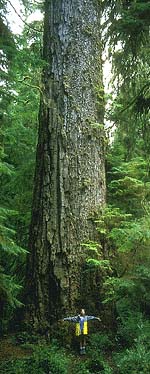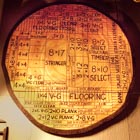Pseudotsuga
Carrière (1867)
Common names
Douglas-fir, Abeto de Douglas [Spanish].
Taxonomic notes
A genus of seven species:
The genus was first described by Carrière with the grand Douglas-fir of North America, Pseudotsuga menziesii, as the type species (it had formerly been placed in Pinus and Abies). Some 22 species and 3 varieties have been described, but many of these were discriminated by Flous (1937) on the basis of subtle distinctions in leaf anatomy and largely have not been upheld (Farjon 1990). The existence of two North American species (one with two or more infraspecific taxa) is well established. In Asia, there is a fair agreement on the number of taxa, as they are geographically and morphologically distinct; however, there is little agreement on the number of species.
| Five Ways to Subdivide the Asian Species of Pseudotsuga |
| Hermann (1982) & Wei et al. (2010) |
P. brevifolia |
P. forrestii |
P. gaussenii |
P. japonica |
P. sinensis |
P. wilsoniana |
| Wu and Raven (1999) |
P. brevifolia |
P. forrestii |
syn. of P. sinensis |
not addressed |
P. sinensis var. sinensis |
P. sinensis var. wilsoniana |
| Farjon (2010) |
P. sinensis var. brevifolia |
syn. of P. sinensis var. sinensis |
P. sinensis var. gaussenii |
P. japonica |
P. sinensis var. sinensis |
syn. of P. sinensis var. sinensis |
| Debreczy and Racz (2011) |
P. brevifolia |
P. forrestii |
P. sinensis var. gaussenii |
P. japonica |
P. sinensis var. sinensis |
P. sinensis var. wilsoniana |
| Gymnosperm Database |
P. brevifolia |
P. forrestii |
P. sinensis var. gaussenii |
P. japonica |
P. sinensis var. sinensis |
P. wilsoniana |
As seen in the table above, Hermann (1982) found 6 Asian species, Debreczy and Rácz (2011) found 4, Wu and Raven (1999) found 3 (being focused on China, they did not address P. japonica), and Farjon (2010) found only 2. The most recent and complete molecular study to throw light on this problem found 6 discrete taxa, which they nominally treated as full species (Wei et al. 2010). They examined five cpDNA regions, two mtDNA fragments and one nuclear gene (LEAFY) in a study that considered all taxa in the genus. They found two clades, one North American and one Asian, with the North American clade resolving all three taxa (P. macrocarpa and two subspecies of P. menziesii). Results for the Asian clade were less clear. The cpDNA evidence placed P. japonica sister to the other Asian species, but the nuclear gene placed it sister to P. sinensis and P. gaussenii, and placed P. brevifolia sister to P. forrestii. The Taiwan species, P. wilsoniana, had two distinct nuclear DNA sequences, one aligned with P. brevifolia and the other with the P. gaussenii-japonica-sinensis clade, suggesting a hybrid origin for this taxon (or, perhaps, two separate introductions of Pseudotsuga into Taiwan, first from one clade and then from the other, with subsequent introgression). These results suggest that there are probably 6 discrete taxa in the Asian clade, and for the time being, I have largely addressed them at species rank, which is the usual practice among Chinese and Taiwanese botanists. I have held P. gaussenii as a variety of P. sinensis largely because of ambiguity: the Flora of China (Wu and Raven 1999) reduced it to synonymy with P. sinensis, but Farjon (2010) found it sufficiently distinctive to warrant varietal rank, and it is distinct but sister to P. sinensis in the molecular analysis (Wei et al. 2010).
Fossil data indicate that Pseudotsuga arose, as did many conifer groups, at about the time of the Eocene/Oligocene change to a globally cooler and drier climate; the oldest known fossil is from Oregon (Lakhanpal 1958). Molecular clock analysis shows that it has been 14.4 to 26.0 million years since the Asian and North American species shared a common ancestor, suggesting that "Pseudotsuga might have originated from North America and then migrated to eastern Asia by the Bering land bridge during the early Miocene" (Wei et al. 2010); this dating agrees with the oldest Asian fossil of Pseudotsuga, Pseudotsuga tanaii Huzioka from the early Miocene Shichiku Flora of northeast Japan (Yabe 2011). Origin in North America with Miocene dispersal to Asia via Beringia is remarkably common in the Pinaceae, also being observed in Abies section Amabilis, Larix, Picea, Pinus subsection Strobus, and Tsuga (Wen et al. 2016, Feng et al. 2021, Qiu et al. 2024).
Description
Evergreen trees. Bark initially smooth with transverse resin blisters, with age becoming reddish brown, thick and corky, deeply fissured into scaly ridges or flaking. Branches often pendulous, irregularly whorled; epicormic branching common on late successional trees. Short (spur) shoots absent; leaf scars transversely elliptic, slightly raised proximally but essentially flush with twig distally. Buds elongate, not or slightly resinous, apex acute. Leaves borne singly, persisting 6-8 years, alternate, short-stalked, linear, flat, green and grooved above, with 2 white stomatal bands each containing 5-8 lines of stomata beneath; 2 marginal resin ducts and 1 vascular bundle. Cones borne on year-old twigs. Pollen cones axillary, cylindric. Seed cones maturing first season, terminal on short branchlets, consisting of numerous spirally arranged scales, each scale 2-ovuled. Mature cones shed whole, deflexed or pendent from a 2-10 mm long peduncle, ellipsoid, ovoid, or cylindric, lacking apophysis and umbo; scales persistent, apex rounded; bracts ± exserted, apex 3-lobed with the middle lobe long and narrow. Seeds winged; cotyledons 2-12. x=12, 13 (Lipscomb 1993, Li 1975, and pers. obs.).
Distribution and Ecology
Canada, China, Japan, Mexico, Taiwan, Tibet, United States, and Viet Nam, in subtropical to cool-temperate forest.
Native distribution of Pseudotsuga; click on icons for species identification. Distribution data from GBIF, 2021.02.22.
Remarkable Specimens
The largest, tallest, and oldest trees are in P. menziesii subsp. menziesii.
Ethnobotany
See the species accounts.
Observations
P. menziesii is one of commonest trees in western North America, an agroforestry species and invasive weed in New Zealand, a common ornamental and agroforestry species in Europe, and easily found in most of the rest of the world's temperate climate zones. The other species are of relatively limited occurrence, are seldom used as ornamentals, and are typically seen only in the largest arboreta.
Remarks
The genus name is derived from the Greek pseudo, false, and the Japanese tsuga, hemlock (Lipscomb 1993).
Citations
Farjon, Aljos. 1990. Pinaceae: drawings and descriptions of the genera Abies, Cedrus, Pseudolarix, Keteleeria, Nothotsuga, Tsuga, Cathaya, Pseudotsuga, Larix and Picea. Königstein: Koeltz Scientific Books.
Feng, Yuan-Yuan, Ting-Ting Shen, Cheng-Cheng Shao, Hong Du, Jin-Hua Ran, and Xiao-Quan Wang. 2021. Phylotranscriptomics reveals the complex evolutionary and biogeographic history of the genus Tsuga with an east Asian-North American disjunct distribution. Molecular Phylogenetics and Evolution 157:107066. https://doi.org/10.1016/j.ympev.2020.107066.
Flous, F. 1937. Révision du genre Pseudotsuga. Bull. Soc. Hist. Nat. Toulouse 71: 33-164.
Hermann, R. K. 1982. The genus Pseudotsuga: historical records and nomenclature. Special Publication 2a, Forest Research Laboratory, Oregon State University, Corvallis. 34pp.
Lakhanpal, R. E. 1958. The Rujada flora of west central Oregon. University of California
Publications in Geological Science 35(1):1-66 ± 11 pls.
Qiu, Xiu-Fei, Yan-Yan Liu, Ge Wu, Cong-Hui Xu, Xin-Quan Liu, Xiao-Yan Xiang, Xiao-Xin Wei, and Xiao-Quan Wang. 2024. Phylogenomic analyses shed new light on the spatiotemporal evolution of global larches: implications for the dynamics of boreal forests. Molecular Phylogenetics and Evolution 202:108240. doi.org/10.1016/j.ympev.2024.108240.
Wei, X.-X., Z.-Y. Yang, Y. Li, and X.-Q. Wang. 2010. Molecular phylogeny and biogeography of Pseudotsuga (Pinaceae): insights into the floristic relationship between Taiwan and its adjacent areas. Molecular Phylogenetics and Evolution 55:776–785.
Wen, J., Z.-L. Nie, and S. M. Ickert‐Bond. 2016. Intercontinental disjunctions between eastern Asia and western North America in vascular plants highlight the biogeographic importance of the Bering land bridge from late Cretaceous to Neogene. Journal of Systematics and Evolution 54:469–490.
Yabe, A. 2011. Pseudotsuga tanaii Huzioka from the earliest Miocene Shichiku Flora of northeast Japan: Systematics and ecological conditions. Paleontological Research 15:1–11.
See also
Little, E.L. Jr. 1952. The genus Pseudotsuga (Douglas-fir) in North America. Leafl. W. Bot. 6: 181-198.


